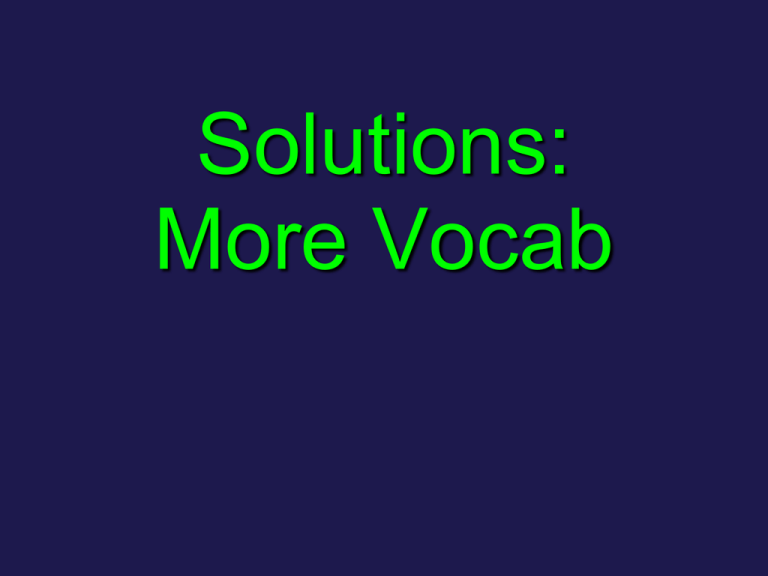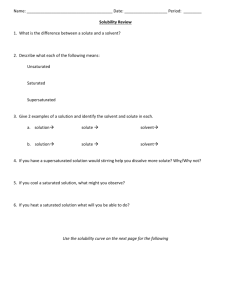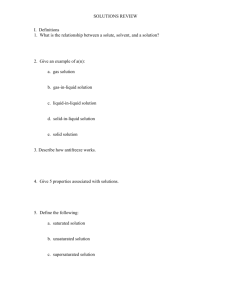solutions vocab
advertisement

Solutions: More Vocab Soluble soluble: capable of being dissolved a substance that dissolves in another substance is said to be soluble in that substance Insoluble a substance that does not dissolve in another substance • solubility: maximum amount substance that dissolves in given amount of another substance – LIMITED amount solute that dissolves in given amount solvent – affected by temperature and pressure • rate of dissolving is different from amount that will dissolve! • rate is how fast • amount is how much factors that affect the rate of dissolving: • temperature • stirring or agitation • amount of surface area of solute • amount of solute already dissolved Dissolving • dissolving is physical change source dissolved covalent substances: produce MOLECULES in solution C6H12O6(s) + H2O(l) C6H12O6(aq) dissolved ionic substances: produce IONS in solution NaCl(s)+H2O(l) Na+1(aq) + Cl-1(aq) Solvation • interaction between solvent molecules & solute particles – solute particles surrounded by solvent particles during dissolving process • solute particles may be: • ions • polar molecules • non-polar molecules • solvent molecules may be: • polar • non-polar Solvation in different systems. Hydration describes solvent-solute interaction when solvent is water hydration of chloride ion also called: molecule-ion interaction Molecule-ion interaction Solute-solvent interaction must be greater than: interaction between solute particles for dissolving to occur Solubility • amount solute dissolved in specific amount solvent at given TEMPERATURE and PRESSURE • units: grams solute per 100 grams solvent Solubility Curves of Selected SOLIDS solubility traces for most solids have (+)’ve slopes; the hotter the solvent, the more solute dissolves Solubility Curves of Selected GASES solubility traces for all gases have (–)’ve slopes Do you know why most fish prefer cold water? Vocabulary Interlude • miscible: two liquids that WILL MIX together in any amounts – water and ethanol are miscible in all proportions • immiscible: liquids that will NOT MIX – oil and water are immiscible Oil & H2O are immiscible Types of Solutions Matter Mixtures Pure Substances Elements Compounds Homogeneous Mixtures = Solutions Heterogeneous Mixtures Conduct current Nonconductor Electricity • What do you need to conduct electricity? mobile, positively charged particles!!!! Vocabulary Interlude • electrolyte: • substance that dissolves in water to form solution that conducts electricity • ions present in solution • non-electrolyte: • substance that dissolves in water to form solution that does not conduct electricity • neutral molecules present in solution electrolyte vs. non-electrolyte Which solution conducts a current? Dilute vs. Concentrated • concentrated –large amounts of solute present • dilute –small amounts of solute present Which solution is most dilute? most concentrated? How can you tell? the stronger the color, the more concentrated the solution to dilute a solution: add MORE solvent Which solution is more concentrated? More dilute? What can you say about the # of solute particles in pictures b and c? the # is the same! Unsaturated Solution less than maximum amount solute that will dissolve at given T and P Saturated Solution • no more solute will dissolve at given T&P • solubility = amount solute required to form saturated solution The solution is saturated when the solute stops dissolving Dynamic Equilibrium in Saturated Solution microscopic level: rate dissolving = rate recrystallization macroscopic level: no apparent change Supersaturated Solution • contains more solute than saturated solution –VERY unstable –have to be clever to make these (need to use heat) Testing for saturation: add additional crystal of solute into solution and see what happens 3 possible results: • crystal dissolves: unsaturated solution • crystal sinks to bottom of solution: saturated solution Bam! Suddenly have lots of solid solute in beaker: supersaturated solution What kind of solution was this? How do terms saturated, unsaturated & supersaturated fit in with the solubility curves? saturated solns: • any point on trace line (max solute dissolved) supersaturated solns: • all points above trace lines (more than max) unsaturated solutions: • all points below trace lines (less than max) A B characterize points A, B, C, D with respect to KNO3 trace line (dilute, concentrated, saturated, unsaturated, or supersaturated) A,C = concentrated & supersaturated C D B=concentrated & saturated D = dilute & unsaturated Solubility Graphs • traces: have positive or negative slopes • most solids have positive slope – the hotter the water, the more solute dissolves – The colder the water, the less solute dissolves • all gases have negative slope – the hotter the water, the less gas dissolves – The colder the water, the more gas dissolves Summary of Dissolving • occurs at surface of solid • interaction: between solute & solvent – interaction called “solvation” – interaction called “hydration” (if solvent is H2O) • involves: change in energy





